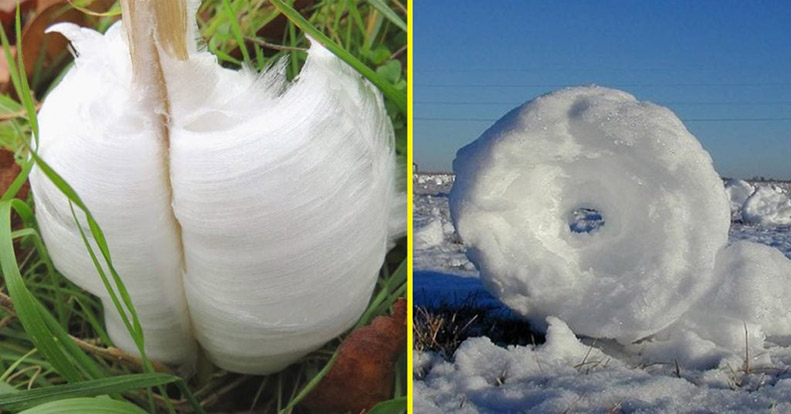We often read headlines of different discoveries of snow rollers and other ice formations. Over the past few years, such ice formations have been found in the US, Canada, and Scotland. It’s really intriguing how mother nature forms such unique ice formations. Let’s look at what goes behind the creation of such ice formations.
1. Snow Rollers
Snow rollers look like a scoop of ice cream. Just like hay, it is a chunk of snow that’s been blown along the ground by the wind, picking up more and more snow while rolling down the hill. Snow rollers are hollow and cylindrical. These rollers have two layers, the first one being icy snow so that the fresh snow accumulates into forming the snow rollers.
2. Frost Flowers
Frost blossom or artic blossoms are found on the surface of newly formed ice lakes. Such frosts form when the wind around the ocean is dryer and colder than the ocean surface. The dryness pulls the moisture off forming little bumps, these bumps turn heavy with the cold. The air releases the pressure creating a delicate feathery two-three inch formation. These frost flowers have three times the salinity of an ocean.
3. Pancake Ice
Also known as pan ice forms on the surface when the ice on the water breaks and spins in a river or a stream in the shape of small circles. The formation and breaking highly depend on the movement of the water and the temperature.
4. Rabbit Ice
This is quite a strange ice formation in colder regions of the world. This is also known as ice wool, ice ribbon, ice flowers. The sap of the plants expands from the stem, cracking open and freezing to form thin layers of ice creating ribbons of ice. The formations on woody plants are even more thin and delicate. These can be found in shaded areas early in the morning.
5. Penitentes
The meaning of penitentes is penitent-shaped snows as they resemble pointed hoods donned by people during the processions at the Spanish Holy Week. The process depends a lot on the heat of the sun and is similar to melting. The only difference here is that the snow directly turns into water vapor. The sublimation creates depressions and the formations lean towards the sun.
6. Needle Ice
Also known as Ice Fringes, this type of ice formation is seen happening when the temperature of the soil is above freezing and the temperature of the air is below freezing. Water flowing below the soil’s surface is drawn up. This is a simple yet stunning formation.
7. Brinicles
These formations occur when regular seawater freezes around extremely briny water from the frozen surface. These are denser and saltier, it falls swiftly toward the bottom with a downward plunge. They freeze everything they touch and are also known as icicles of death.
8. Striped Icebergs
Icebergs are white blocks of ice that float on the surface of the water. In the Arctic regions, the icebergs are formed striped in different hues, namely, blue, black, green. Blue stripes indicate the pure frozen water as air bubbles do not freeze in them and the white hue is the reflection of light.
9. Ice Circles
Such ice formations occur in rivers, streams, and creeks. Ice circles appear and vanish quickly when the temperature of the river is at a freezing level or lower.
10. Jewel Ice
At the mouth of the Tokachi River in Japan, there is a beach where you will find gems that could be mistaken for diamonds. Such a formation is not seen anywhere else in the world. They are formed when the temperature drops and the crystal clear water from the river freeze to form ice fragments.
So when are you heading to the colder regions to see these unique creations by mother nature?

